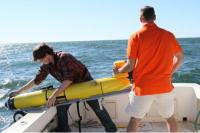 Robots are being increasingly being used to gather data at sea. Here is a fascinating undersea glider design in use by the Coastal Ocean Observation Lab (COOL) at Rutgers University, which uses gravity and buoyancy for propulsion, allowing to it remain at sea for months at a time while it records water temperatures, depths, salinity and more, sending the data to shore by satellite phone each time the robot periodically surfaces. Changes in water temperature as a function of depth have proven to be highly useful in predicting hurricane intensity.
Robots are being increasingly being used to gather data at sea. Here is a fascinating undersea glider design in use by the Coastal Ocean Observation Lab (COOL) at Rutgers University, which uses gravity and buoyancy for propulsion, allowing to it remain at sea for months at a time while it records water temperatures, depths, salinity and more, sending the data to shore by satellite phone each time the robot periodically surfaces. Changes in water temperature as a function of depth have proven to be highly useful in predicting hurricane intensity.
The 6-foot-long, 115-pound autonomous underwater vehicles (AUV) operates as underwater gliders. A small amount of water in pumped into the forward end of the glider when on the surface, making it slightly negatively buoyant. As the robot sinks, lift off the glider wings gives it forward motion. As it approaches the bottom, the water is pumped out, making it slightly positively buoyant. Again, lift off the glider wings generates forward motion as it moves slowly toward the surface. These gliders are the latest version of “Slocum gliders.” In 2009, the Rugers’ Scarlet Knight glider successfully transited the Atlantic.
Underwater Gliders Gather Data To Help Predict The Next Big Storm
